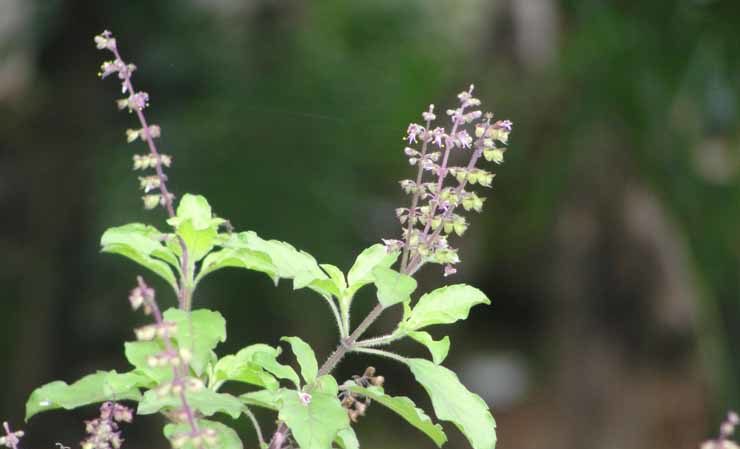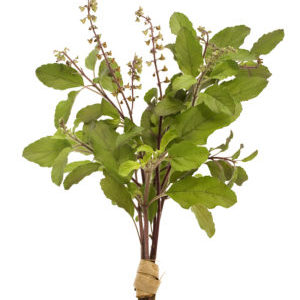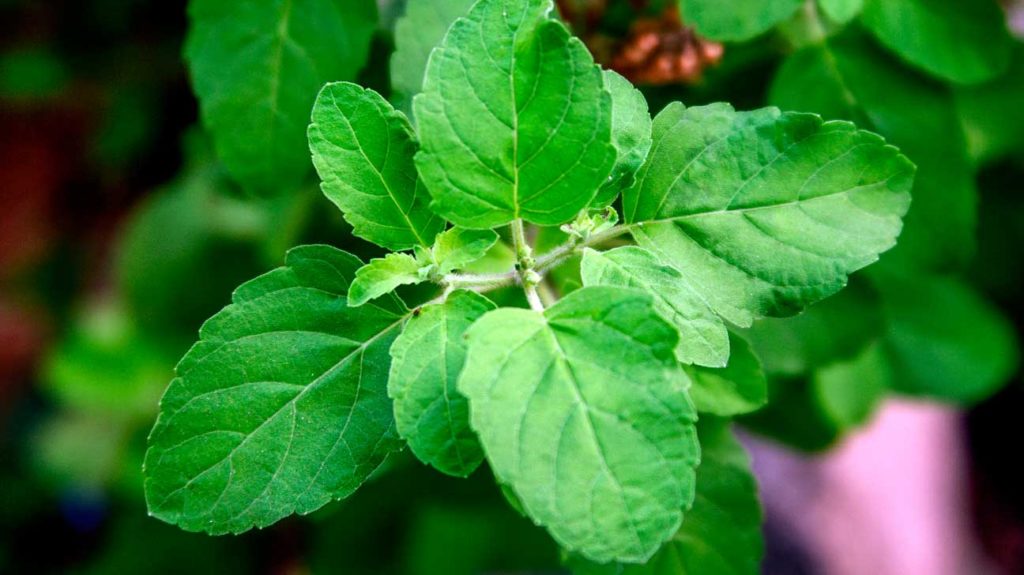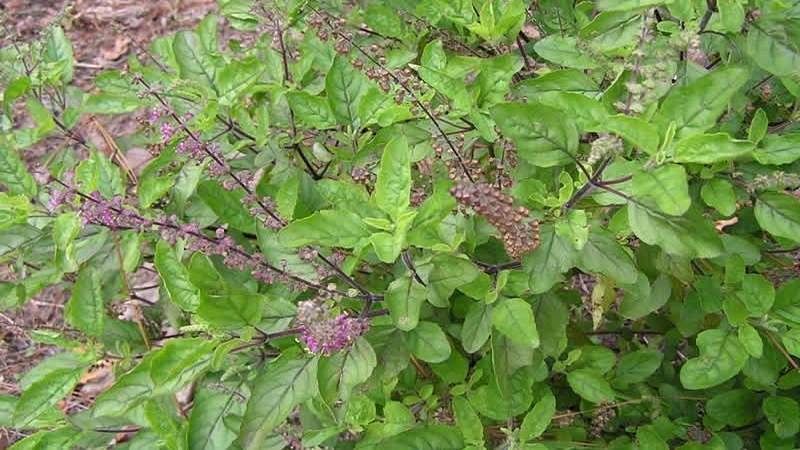Thin-colored basil - uses and benefits
Tulasi (Tulasi, thin-flowered, Indian or Thai basil) is considered to be an amazing plant. In many countries, he is credited with mystical properties - he helps to find harmony, purify the soul and achieve peace. It is also an effective remedy in the treatment of many diseases.
In the article, we will tell you in detail about the beneficial properties of the holy Thai basil.
The content of the article
Description of the basil delicate

Basil thin-flowered (sacred), or tulasi, is a perennial herbaceous shrub of the Lamiaceae family native to India. An adult plant reaches 60 cm. The leaves of tulasi are green or purple, toothed, up to 5 cm long. Short hairs cover the surface of the stem and leaves. The flowers are white, with a purple tint, collected in false whorls.
In addition to India, tulasi is also found in other Asian countries: Thailand, Arabia, Indonesia and the Philippines. In temperate climates, it is grown as an annual plant.
What is the sacredness of the Indian basilica
A tulasi bush grows in the home of almost every religious Indian. The veneration of this plant cannot be compared with the pagan worship of stone or wooden idols. Respect is not given to a material object, but to the person who took this appearance.
According to the ancient scriptures (Puranas), one great saint living in the spiritual world, at some point was so imbued with the sufferings of ordinary people that she decided to go down to earth and share their fate. She took the form of a small bush, and people began to worship him for the purpose of cleansing and receiving grace. Tulasi translates as “incomparable”. It is believed that this saint is unparalleled in her devotion to God, therefore he blesses all who venerate the sacred basil.
In Vishnuism, Tulasi is worshiped as the embodiment of Lakshmi, the goddess of fertility and happiness. In the traditions of Krishnaism, the plant personifies Radha - one of the female forms of God.
The leaves of thin-colored basil are used daily in ritual ceremonies; beads and rosary beads are carved from its branches and collected. Long garlands are woven of leaves and flowers, which adorn the necks of the statues of deities.
Reference. In Thailand, the delicate basil is called kaphrao and is popular in cooking. Tulasi stems and leaves are fried with meat and seafood.
Beneficial features
The beneficial properties of holy basil are explained by the chemical composition of the essential oil obtained from the stems of the plant. Tulasi is widely used in pharmacology and Ayurvedic practices.
The main active ingredient is eugenol, which has a disinfecting, analgesic effect.

Other useful ingredients:
- cineole provides an expectorant, disinfecting and anesthetic effect;
- methyleugenol - sedative, antispasmodic;
- carvacrol has an antibacterial effect;
- ursolic acid speeds up metabolism.
An adult plant accumulates phosphorus, calcium, folic acid and B vitamins in its leaves.
Medicines and infusions, which contain thin-colored basil, have a tonic effect on the human body.
Tulasi helps to solve many health problems:
- Supports defenses. Due to its antibacterial, antiviral and antifungal effects, it naturally stimulates the immune system.The susceptibility to disease is reduced, and the healing process is much easier. Tulasi helps to treat colds and flu, viral and bacterial diseases (malaria and typhoid fever).

- Normalizes sugar levels. The plant's eugenol stimulates pancreatic activity and helps control insulin levels. Sugar values are leveled out with regular use. The remedy is prescribed for diabetes as a natural supplement to improve the condition.
- Fights stress. It is used as a natural replacement for antidepressants and sedatives. Normalizes the work of the adrenal glands, which produce the stress hormone. Anxiety goes away, the emotional state becomes more stable, mood swings disappear.
- Cleans the kidneys. Tulasi removes toxins that accumulate in the body. Helps control uric acid levels, exceeding which is considered the main cause of kidney stones. Thin-colored basil is indicated for disorders of kidney function, but it is prescribed only after consulting a specialist.
- Improves the functioning of the digestive system, accelerates the absorption of useful components, removes constipation, bloating, diarrhea. It has a beneficial effect on the stomach and intestines.
- Reduces the risk of developing malignant tumors. The growth of blood vessels that feed cancer cells slows down. The tumor is deficient in nutrition, it stops developing and shrinks. Tulsi extract is used as part of complex anti-cancer therapy.
- Normalizes hormones. Speeds up metabolism, removes harmful substances and decay products.
- Has anti-inflammatory effect. The disturbed balance of fatty acids, according to Indian medicine, forms a chronic focus of inflammation. Basil helps to normalize this balance, thereby reducing inflammation in the body and reducing the risk of developing the disease.
Read also:
Is it possible to plant basil before winter and how to do it
Contraindications
Like most medicinal plants, holy basil has restrictions on its use:
- Pregnancy and lactation. Despite the fact that Asian women use tulasi during periods of childbearing and breastfeeding, experts point out the need for prior consultation for those who are not used to tulasi.
- Childhood.
- Individual intolerance to the active ingredients.
- A problem with blood clotting. The substances contained in the holy basil, with prolonged use, thin the blood. This increases the risk of internal bleeding.
Cultivating tulasi
With proper care and conditions, fine basil grows successfully in garden beds, in a greenhouse, in a pot on a balcony or on a home windowsill.
Conditions for growth

Tulasi is a tropical plant... It requires a lot of sunlight and plenty of water to grow. On the street, basil is grown as an annual plant, and indoors, with the onset of cold weather, they provide additional illumination, making the bush comfortable all year round.
Sowing seedlings
Basil seeds are poured into small boxes filled with soil. Sprinkle the seeds on top with earth, water and cover with a transparent film to maintain moisture.
Comfortable temperature for seed germination is + 22 ... + 26 ° C. In such conditions, sprouts appear on the 5-7th day.
Open ground transplant
The seedlings are moved to a permanent place as soon as the sprouts reach a height of 5 cm. When the basil has released 4-6 leaves, pinch the top of the plant. Then the tulasi will grow wide and the plant will begin to bush.
Further care
Further care includes timely watering, feeding and pruning.

Watering
The best moisture for watering tulasi is rainwater. However, when growing a plant on a balcony and windowsill, ordinary standing tap water is also suitable. Some growers recommend boiling water. If the water is chlorinated, it is defended for several days before boiling, stirring occasionally.
Water regularly - 1-2 times a week in moderation. Waterlogging of the soil must not be allowed.
Top dressing
A light textured soil is best for growing thin-colored basil. To feed the bush, nitrogen fertilizers are used, which stimulate the growth of green mass.
Pruning
The leaves are cut when the basil grows to 10-15 cm. During the flowering period, the leaves and shoots are most fragrant and juicy. After cutting, the bush is fed by watering with a solution of 2-3 g of urea per 1 liter of water.
With strong foliage thickening, the plant is thinned out to open access to free ventilation.
Read also:
When to harvest and how to dry basil properly.
Plant compatibility: what to plant next to basil and why it is important.
How to properly freeze basil for the winter: a selection of the best ways.
Conclusion
Holy basil is unpretentious in care and feels comfortable in a pot on a windowsill. The beneficial properties of its leaves and stems will help in the treatment of many diseases and will have a beneficial effect on overall well-being.